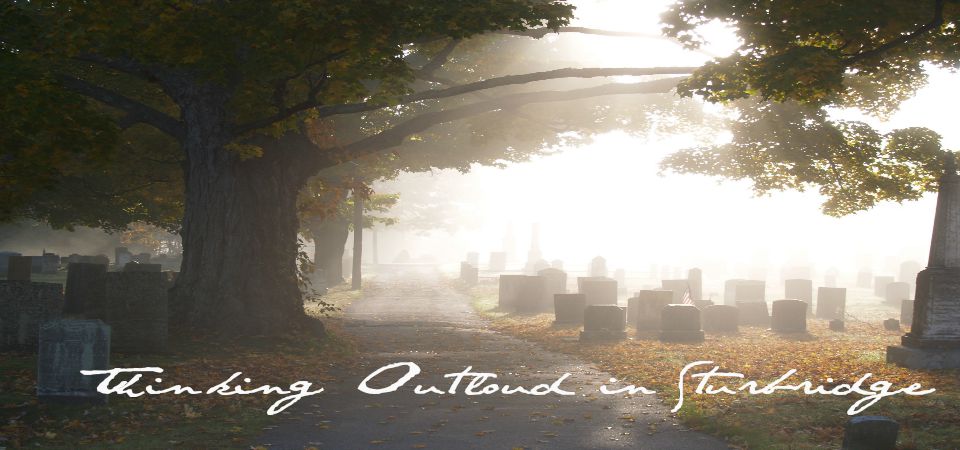Sixty miles west of Boston, Massachusetts there is the small New England town of Sturbridge. Located at the junction of I-90 (The Mass Pike), and I-84 it has become known as the "Crossroads of New England". The town was first settled over 300 years ago, and like other small New England towns it has grown just enough over the years to be in a difficult place today. How do we embrace the future without forgetting how we got to our present? How do we attract the right kind of growth, and maintain who we are? And, what about our culture out here in Central Massachusetts?
These pages will cause one to think about how to protect what we have, our future direction, and how to move on in the very best way.
Those thoughts, and other ramblings, will hopefully inspire more thought, conversation, action, and occasionally a smile...
...seems to be working so far
Saturday, September 20, 2008
Our Stones
Sturbridge Stone Piles (MA)
Long before there was a concern for the height of gravestones here in town there was a people that lived on this land that built stone monuments all over our town. The Native Americans, and ancient people that lived here are responsible for scores of "monuments", and if you are curious enough, you can find them.
Why were they built? I haven't a clue. Some may be burial grounds, others may mark where significant events occurred, or maybe markers for the passing seasons. The point is, they are here, and all around us, and were obviously very important to the people that built them.
These "rock piles" remind us that we are newcomers to this place. Long before they discovered the graphite here, there were peoples that lived undisturbed for eons. Hard to imagine a world devoid of Route 20's, fast food, motels, and "primitive decor". These purposely built piles of stones are hidden in the forests throughout the area, and are invaluable to the historian in telling more about the history of our town.
Yesterday, I took a short walk into the woods with a friend of mine that is somewhat of an expert in local history. I had mentioned some stone piles that I had found a couple of years ago that seemed more than just a random placing of rocks. Curious, he asked to be shown where they were.
Our "hike" wasn't a long one, but over land that is seldom, if ever walked on. We crossed a small stream and in a short bit I found the pile I told him about. He agreed, this was not just a pile of stones. He had seen Native American burial grounds before, and this site reminded him of the stone monuments he had seen before. He has a friend that is Nipmunc, and very knowledgeable in this area, and he is going to run it by him, and get his feedback.
As we wandered about, in the area of the stones, we found a few more piles. Each one purposely placed and mostly covered with years, and years of forest debris. Early settlers would not have left piles of rock in the middle of the fields they had cleared, but rather placed them in a wall surrounding the field, and out of the way of the plow.
The slide show above is not of the piles we visited yesterday, although the photos were taken here in town, it is from a website I found on the internet. The photos were taken by someone else that had the same curiosity we have about the rock piles in our town. The photos give a good sampling of what there is in the woods around us.
The stones can tell us much if we are willing to see. Disturbing them is not something that should ever be done, even archaeologist won't disturb them unless there is the chance of a major find, and then it is something that will be discussed at length.
Seems stones have been something the peoples in this area have paid attention to over the ages. I guess we're no different today judging from the activity at the selectmen's meeting this week regarding the tombstones at the cemetery. Stone monuments are still very important to our culture.
We may be called Modern Man, but we still have a bit of Stone Age in us.
For more information regarding Rock Piles in New England go to
http://rockpiles.blogspot.com/
http://www.stonewall.uconn.edu/PrimerHist.htm
http://www.stonewalljack.com/
http://mysterious-hills.blogspot.com/2006/05/washington-stone-formations.html
http://www.travellady.com/Issues/January07/3822STONEHENGE.htm

I'm glad you didn't post where these piles are. There are pot hunters who will ravage such places leaving every stone overturned, taking artifacts and sacred items for themselves, whether colonial or prehistory.
ReplyDeleteConsider that some stone piles are the result of clearing fields for use as farming. They could be pedestal foundations which supported a building or buildings. Stone walls also functioned as fences for animals. Some are rock piles that were started for a purpose but never used.
From what I understand, natives didn't usually build cairns and surround them by stone walls. Colonials did that, and everything had a useful purpose.
I'd be surprised if this was american indian; my opinion is, if it was, it wouldn't be so well marked and easy to trip over.
It's always fun and interesting to think and wonder about such things. I recommend that you contact a professional archaeologist for an opinion so you can gauge the age of the complex; if there truly is such a site in Sturbridge, it should be permanently preserved and protected.